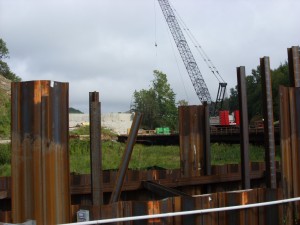
The construction industry is split on whether Connecticut should pursue a streamlined contracting process for some transportation projects that is gaining momentum in other states.
Under design-build plans elsewhere, states award a single contract for project architecture and engineering services, followed by one for actual construction; rather than putting the design and construction phases out to bid separately.
In Connecticut, the state Department of Public Works is allowed to bid projects on a unified, design-build basis. In 2009 it awarded a contract on that basis for a secure-treatment facility for teenage girls in Bridgeport, but the project bogged down amid protests from city residents. Amenta/Emma Architects P.C., which has a Stamford office, was to lead the design phase under the original contract, with Farmington-based KBE Building Corp. to build the planned facility.
The Connecticut General Assembly is considering a plan that would allow the Connecticut Department of Transportation (ConnDOT) to try the concept on a pilot basis.
In an 80-page report commissioned by ConnDOT and released last summer, the Connecticut Academy of Science and Engineering (CASE) endorsed the concept, noting that the department already has the authority to modify or eliminate the bidding process for emergency projects.
CASE added that several states have rushed design-build authorizations into law since the passage of the American Recovery and Reinvestment Act of 2009, which flooded the transportation sector with new funding ”“ but with a “use it or lose it” clause.
CASE cautioned, however, that speedy environmental permitting is a critical component for design-build to work and notes that the Connecticut Department of Environmental Protection in the past has tended to bog projects down with its process for analyzing their impact.
Gov. Dannel P. Malloy hopes to consolidate DEP under a larger Connecticut Department of Energy and Environment led by Yale University professor Daniel Esty, who has significant experience in helping corporations deal with the nuances of environmental law. As of late March, Malloy had yet to name a permanent head of ConnDOT, which has been led since last June by Jeffrey Parker following the abrupt ouster last year of his predecessor Joseph Marie.
Connecticut is just one of four states today that does not have design-build in place for its transportation department, according to Parker; he cites improved quality as a major factor in favor of design-build, along with time and cost savings.
“Some projects may have specific timeframes established for the use of ”¦ funds,” Parker said. “There have been many technological advances through the years and more innovations are being pursued. Accelerated project deliveries should be considered to enable Connecticut to best utilize funding opportunities and satisfy public expectations on transportation projects.”
Also speaking in favor of design-build was Paul Brady, executive director of the American Council of Engineering Companies of Connecticut in Middletown.
“Design-build is but one of a number of alternative contracting methods ”¦ (that extend) our limited tax dollars,” Brady said.
Don Shubert, for one, is not buying it in his role as president of the Connecticut Construction Industries Association Inc. in Wethersfield, saying ConnDOT lacks the fundamental culture for design-build to work here.
“Our DOT right now is very compliant and proscriptive-oriented, and they wouldn”™t allow for the innovation that is really one of the benefits of design-build,” Shubert said.
He added that ConnDOT has suffered in the past from suspicions in the construction industry that its staff have awarded contracts on an discretionary and arbitrary basis, rather based on the actual best bid.
“When you do design-build, you”™re allowing the Department of Transportation to have discretion in the contractor selection process,” Shubert added. “We”™re not saying that there would be mischief in that ”“ but as far as the industry is concerned, we”™ve worked for six years now to reform contracting in Connecticut ”¦ We feel that the last thing that Connecticut needs right now is another contracting mishap. We”™re afraid of another project going bad.”



















